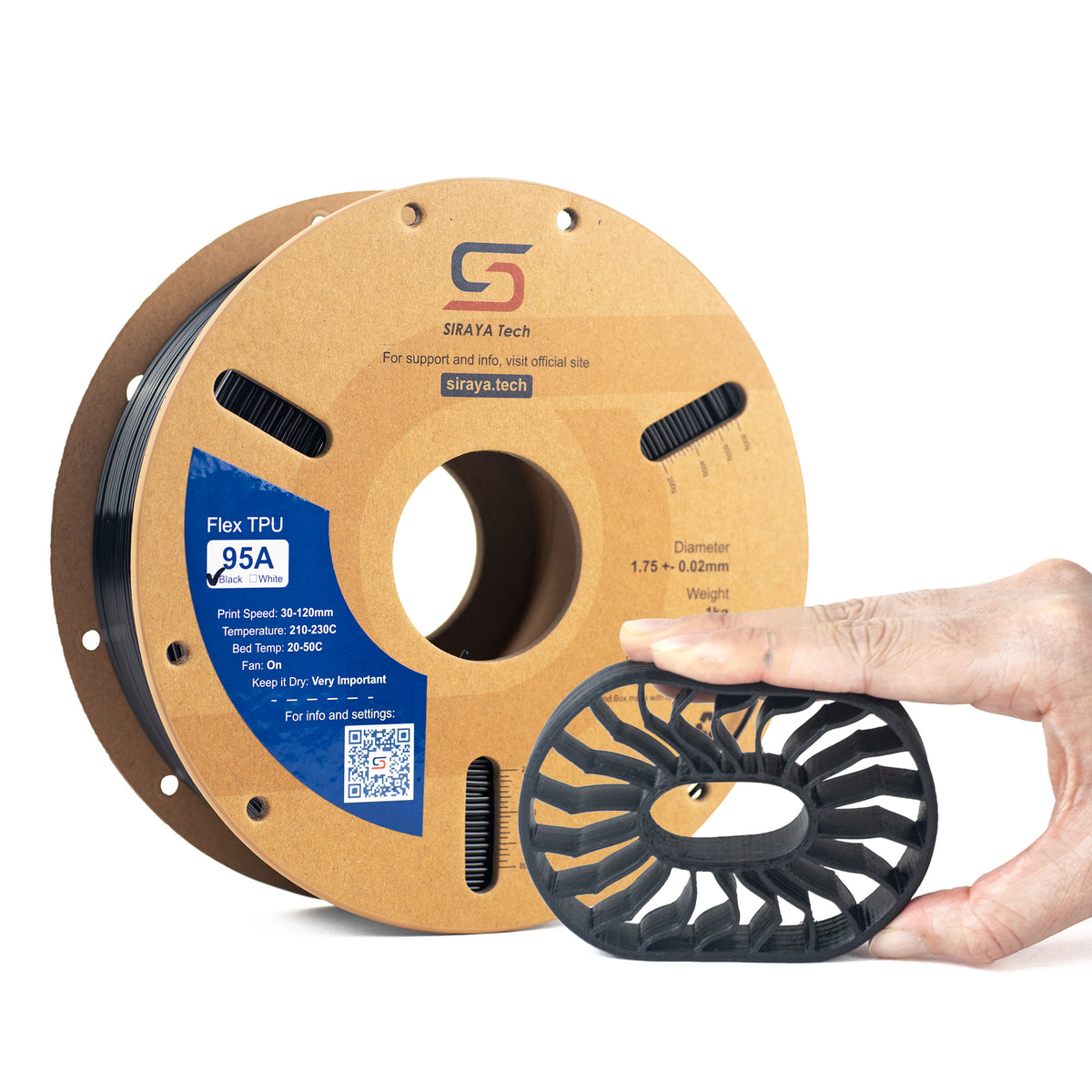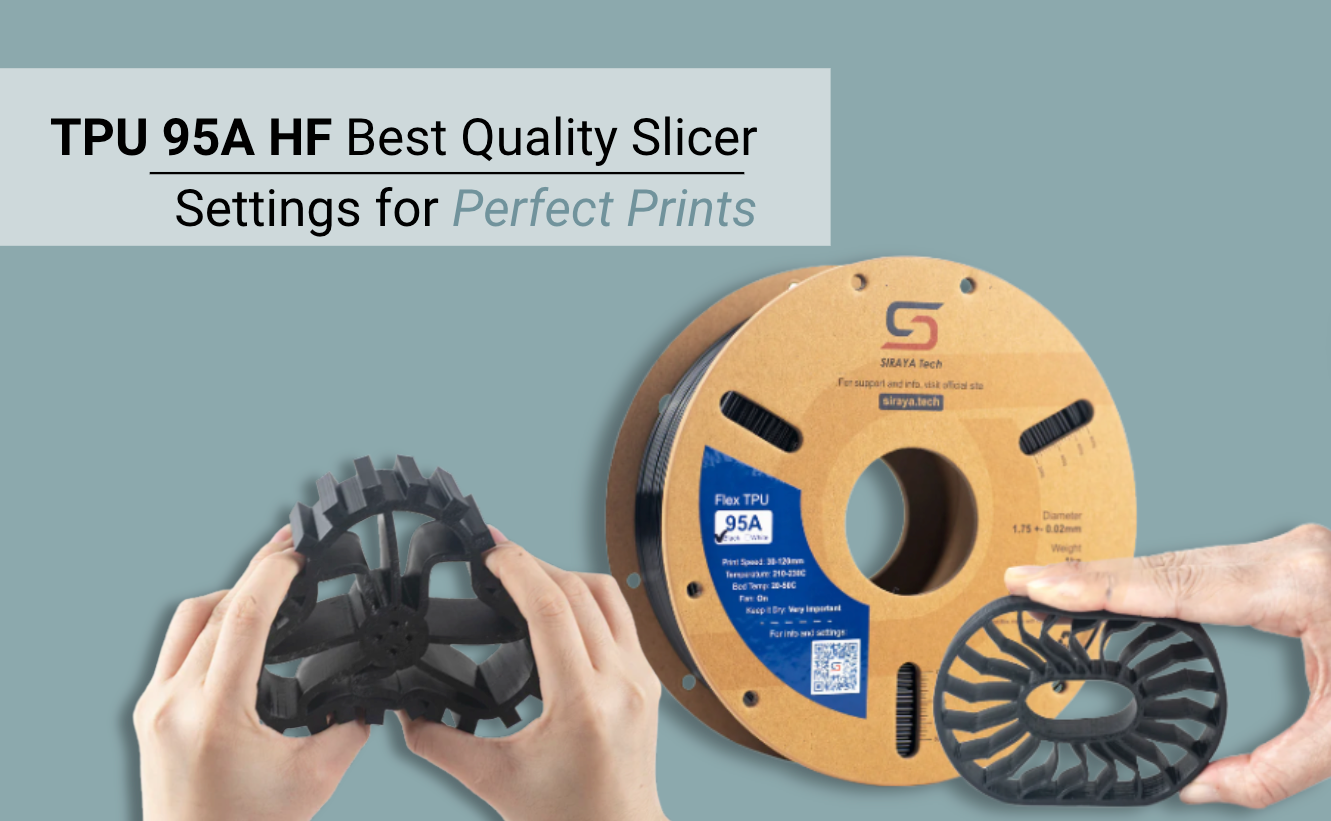If you’ve ever tried printing with TPU 95A HF filament, you already know it’s both rewarding and tricky. TPU (thermoplastic polyurethane) is a flexible material known for its elasticity, abrasion resistance, and durability.
The 95A HF variety offers a balance between flexibility and rigidity, making it a popular choice for phone cases, RC car tires, and wearable parts.
But here’s the catch: TPU can be frustrating to print without the correct settings. Prints may string, clog, or fail to adhere to the bed. That’s why knowing the best slicer settings for TPU 95A HF is the difference between a failed print and a smooth, professional-looking model.
This guide will walk you through proven slicer settings, practical troubleshooting, and expert tips to help you get the best quality prints with TPU 95A HF.
TPU 95A HF Best Settings at a Glance:
- Use a nozzle temperature between 220°C and 240°C for optimal extrusion.
- Set bed temperature around 30–40 °C with an adhesive like a glue stick or a PEI sheet for good adhesion.
- Print speed should be slow, typically 30–40 mm/s, to avoid filament buckling.
- Retraction distance 1–2 mm and slow retraction speed reduce stringing and jams.
- Layer height of 0.2–0.3 mm balances detail with layer bonding.
- Use a 0.4 mm nozzle size; larger nozzles help filament flow smoothly.
- Keep filament dry by storing it in sealed containers with desiccants.
Siraya Tech Flex TPU 95A Filament

- Siraya Tech Flex TPU 95A balances flexibility and toughness for functional parts.
- High flow formulation supports faster print speeds with clean surfaces and strong layer bonding.
- Print friendly: low warp, low odor, and excellent bed adhesion for consistent results.
- Durable, bendable parts resist abrasion and can support substantial loads—great for gaskets, grips, hinges, and covers.
- Compatible with most FDM printers; optimized for direct drive. Bowden works with slower speeds and minimal retraction.
- Moisture-resistant, resealable aluminum bag preserves quality; shelf life up to 3 years.
What is TPU 95A HF?
TPU is a flexible thermoplastic known for its elasticity, wear resistance, and shock absorption. The “95A” refers to its Shore hardness rating.

Shore A 95 is flexible but firm enough to retain shape under stress. The “HF” stands for high flow, meaning it extrudes more easily than regular TPU if your slicer is tuned correctly.
Printing Challenges with TPU 95A HF
Unlike PLA or PETG, TPU behaves like a soft, squishy material inside your printer’s extruder.
This can lead to:
- Filament buckling inside the extruder.
- Stringing and oozing between travel moves.
- Poor adhesion on the print bed.
- Under-extrusion or clogs if the filament absorbs moisture.
Due to these challenges, slicer settings are more important than ever when working with TPU.
👉 Check Out: Siraya Filament Settings for Bambu 3d printers
Essential Slicer Settings for TPU 95A HF
Nozzle Temperature
- Best Range: 220–240 °C
- Higher temps improve layer adhesion but increase stringing.
- Lower temps reduce stringing but risk under-extrusion.
- A good starting point is 230 °C.
💡 Tip: Always print a temperature tower with your filament brand to find the sweet spot.
Bed Temperature
-
Best Range: 30–40 °C
- Use adhesive materials like a glue stick or a PEI sheet for better stickiness.
- Helps prevent warping and improves first-layer adhesion.
👉 Read Our Guide: Siraya Tech PEBA Air 70A-95A User Manual
Best Print Speed Settings
General Print Speed
- TPU needs slow printing. (Slower speeds improve print quality but increase print time.)
- Typical speed: 30–40 mm/s.
- Anything faster may cause the extruder to buckle.
First Layer Speed
- Slow first layers are key.
- 15–20 mm/s helps the filament grip the bed properly.
Travel Speed
- Lower travel speeds (80–100 mm/s) reduce stringing.
Retraction and Extrusion Settings
Retraction Settings
-
Retraction Distance: 1–2 mm
-
Retraction Speed: ~20 mm/s
- Keep it minimal, or TPU will jam in the extruder.
Extrusion Multiplier (Flow Rate)
- Start at 100% flow rate.
- Adjust by ±5% depending on whether you see over- or under-extrusion.
💡 Direct drive extruders handle TPU better than Bowden setups, since TPU is soft and can flex inside the tube.
Cooling and Fan Settings
Cooling Recommendations
- 50–70% cooling for bridges, overhangs, and detailed parts.
- Avoid 100% fan speed – it causes weak layer bonding.
Layer Bonding vs. Flexibility
- For stronger prints, reduce cooling to 40–50%.
- For smoother finishes, increase cooling toward 70%.
Layer Height and Infill Settings
Layer Height
-
0.16 mm for fine details like phone cases.
- 0.28 mm for faster, functional prints.
Infill Percentage
- 20–30% for flexible prints (phone cases, straps).
- 40–60% for rigid or semi-flexible parts (hinges, industrial dampeners).
Bed Adhesion Tips
Surfaces That Work Best
- Blue painter’s tape for grip.
- PEI sheets for reliability.
- A glue stick for a quick adhesion fix.
First Layer Adhesion
- Increase first-layer extrusion multiplier to 110%.
- Print slower and hotter for the first layer.
Brims and Rafts
- Add a brim to prevent corners from lifting.
- Use a raft only if adhesion continues to fail.
👉 Read RElated Article: What Is a Filament and How Does It Power 3D Printers
Advanced Tips for Printing TPU 95A HF
Getting perfect prints with TPU 95A HF requires more than just the right slicer settings. This flexible filament needs proper preparation, tuning, and maintenance to deliver smooth results and durable parts.
Below are expert‑level tips to help you avoid print defects, control extrusion flow, and improve bed adhesion every time.
Drying and Storage
TPU filament is hygroscopic, meaning it easily absorbs moisture from the air. If not dried properly, the trapped water turns into steam during printing, which can cause bubbles, uneven surfaces, and weak layer bonding.
- Always dry TPU 95A HF filament at 70°C to 90°C for 8 to 12 hours before printing.
- Use a filament dryer or an oven with temperature control to maintain even heat.
- After drying, store the filament in an airtight container with desiccant packs or silica gel to keep it moisture‑free.
- For long‑term storage, label each spool with the drying date and keep it sealed when not in use.
Proper drying and storage help ensure consistent extrusion, improve surface quality, and extend the lifespan of your filament.
Pressure Advance and Volumetric Controls
TPU’s flexible nature makes it prone to flow inconsistencies if extrusion settings are not optimized. Using pressure advance (also called linear advance) helps compensate for the lag between pressure build‑up and release inside the extruder.
- Enable pressure advance in your slicer to smooth out extrusion and reduce stringing or blobbing on corners.
- Adjust settings gradually to match your printer’s hardware and extrusion responsiveness.
- Monitor volumetric flow limits, as printing TPU too fast can exceed the extruder’s capacity and cause jams or under‑extrusion.
- Keep print speeds moderate for stable pressure control and cleaner layer transitions.
Tuning these settings takes time, but once optimized, you’ll notice more accurate dimensions and cleaner prints.
Direct Drive Extruder Advantage
When printing flexible materials like TPU, direct drive extruders offer a major advantage over Bowden setups. Because the extruder is mounted close to the hotend, filament feeding is shorter, more controlled, and less prone to bending.
- Choose a direct drive system to achieve steadier TPU feeding and reduced print failures.
- Keep the filament path as short and straight as possible to minimize buckling or tangles.
- If you must use a Bowden setup, consider using a Capricorn tube and slowing feed rates to maintain tension control.
A well‑tuned direct drive printer delivers consistent extrusion pressure, especially when printing intricate TPU parts.
Bed Adhesion Techniques
Bed adhesion plays a crucial role in avoiding warping and ensuring that the first layer sticks properly to your print surface. TPU 95A HF can be flexible and slightly tacky, so extra steps help it stay secure throughout the print.
- Use a brim or a small raft to increase the surface area and prevent edges from lifting.
- Clean the print bed regularly with isopropyl alcohol to remove oils and residue that can hinder adhesion.
- Heat the print bed to around 40°C to 60°C for best results.
- Choose a build surface compatible with flexible filaments, such as PEI sheets or textured plates.
Good adhesion ensures smooth prints from start to finish and reduces the risk of layer shifting or curling.
👉 Read Our Guide: What Is TPU Filament: An Easy Guide For Smart 3D Printing
Conclusion
Printing TPU 95A HF filament at its best quality depends on carefully tuned slicer settings.
Maintaining nozzle temperatures between 220 and 240°C, printing at a slow speed of around 30–40 mm/s, carefully managing retraction, and ensuring proper bed preparation all contribute to producing great flexible prints.
Advanced users can optimize their extrusion process with drying, pressure advance, and direct drive extruders for even smoother results. Keep your filament dry and experiment with small test prints to perfect your personal settings.
👉 Explore well-curated filament selections to complement your prints:
FAQs About TPU 95A HF Best Quality Slicer Settings
What is the best speed for TPU 95A HF printing?
Start at 40–60 mm/s for reliable flow and first-layer control, then step up to 70–90 mm/s as your tuning improves. Keep retraction very low (0–1 mm on direct drive, 1–2 mm on Bowden) and reduce acceleration to limit buckling. A 210–235 °C nozzle and 30–60% part cooling usually work well. Always run a small speed tower to confirm your exact setup.
Do I need to dry TPU before printing?
Yes. TPU is hygroscopic and quickly absorbs moisture, which causes popping, stringing, and weak layers. Dry spools at about 50–55 °C for 4–6 hours, then store in a dry box with desiccant. If you hear sizzles or see bubbles, dry again before printing.
Can TPU 95A HF be printed on a Bowden extruder?
Yes, but it needs extra care because the soft filament can compress in the tube. Use slow to moderate speeds (35–60 mm/s), minimal retraction, and gentle acceleration. Make sure the filament path is well constrained and keep the spool feeding smoothly. Direct drive is easier, but a well-tuned Bowden can still produce clean results.
Why is TPU printing slower than PLA?
TPU is flexible, so the filament compresses under pressure, which delays extrusion changes and increases stringing risk. Lower speeds, reduced acceleration, and tiny retractions give the hot end time to stabilize flow. Cooling and temperature windows are narrower than PLA, so quick moves tend to hurt surface quality. Going slower improves dimensional accuracy and layer bonding.
Is TPU 95A HF good for outdoor parts?
Generally yes. TPU resists abrasion, impact, and many chemicals, and black or UV-stabilized grades handle sunlight better than light colors. Avoid high-heat spots since TPU softens well below 100 °C; for hot, sunny environments, PETG or ASA may last longer. Seal or coat parts if they will see constant sun and water to extend service life.

